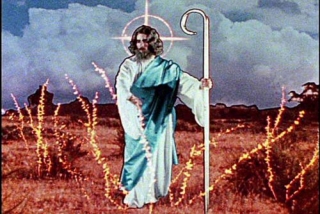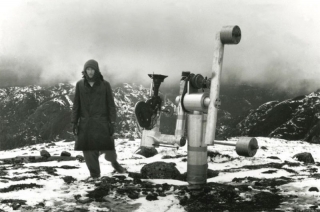Date: 18 September 2007 | Season: ZXZW 2007
CINEMA FOR THE EYES AND EARS
ZXZW Festival at Tilburg FilmFoyer
Tuesday 18 September 2007, at 9pm
The potential for combining image and sound has been explored since the invention of cinema. This primer of classic works of the international avant-garde demonstrates some of the possibilities specific to the film medium, from the flickering frames of Tony Conrad, Paul Sharits and John Latham to the intricate optics of Daina Krumins, Malcolm Le Grice, and others. Featuring soundtracks by Brian Eno, Rhys Chatham, John Cale and Terry Riley. All films will be shown on 16mm.
Peter Kubelka, Arnulf Rainer, Austria, 1958, 8 min
Wojciech Bruszewski, YYAA, Poland, 1973, 5 min
John Latham, Speak, UK, 1968-69, 11 min
Malcolm Le Grice, Berlin Horse, UK, 1970, 8 min
Daina Krumins, The Divine Miracle, USA, 1973, 5 min
Paul Sharits, Axiomatic Granularity, USA, 1972-73, 20 min
Lis Rhodes, Dresden Dynamo, UK, 1974, 5 min
Tony & Beverly Conrad, Straight and Narow, USA, 1970, 11 min
The programme also screened in The Wire 25 season at London Roxy Bar and Screen on Tuesday 30 October 2007, at 8pm.
PROGRAMME NOTES
CINEMA FOR THE EYES AND EARS
ZXZW Festival at Tilburg FilmFoyer
Tuesday 18 September 2007, at 9pm
ARNULF RAINER
Peter Kubelka, Austria, 1958, 35mm, b/w, sound, 8 min
“He has even created a film whose images can no more be ‘turned off’ by the closing of eyes than can the soundtrack thereof it (for it is composed entirely of white frames rhythming thru black inter-spaces and of such an intensity as to create its pattern straight thru closed eyelids) so that the whole ‘mix’ of the audio-visual experience is clearly ‘in the head’, so to speak: and if one looks at it openly, one can see ones own eye cells as if projected onto the screen and can watch one’s optic physiology activated by the soundtrack in what is, surely, the most basic Dance of Life of all (for the sounds of the film do resemble and, thus, prompt the inner ear’s hearing of its own pulse output at intake of sound).” (Stan Brakhage)
YYAA
Wojciech Bruszewski, Poland, 1973, 35mm, colour, sound, 5 min
“The author of the film (appearing on the screen) is shouting “YAAAH…” The light comes from four sources being switched at random (this takes between 1 and 8 seconds) by an electronic device. In any moment, only one of the four lamps casts light on the filmmaker. Each light-change is accompanied by a different voice modulation of the author’s voice. The film technique makes it possible for the author to exhale for several minutes. The alternating close-ups and half-close-ups are totally unjustified.” (Wojciech Bruszewski)
SPEAK
John Latham, UK, 1968-69, 16mm, colour, sound, 11 min
“Speak is his second attack on the cinema. Not since Len Lye’s films in the thirties has England produced such a brilliant example of animated abstraction. Speak burns its way directly into the brain. It is one of the few films about which it can truly be said, ‘it will live in your mind’.” (Ray Durgnat)
BERLIN HORSE
Malcolm Le Grice, UK, 1970, 16mm, colour, sound, 8 min
“Berlin Horse is a synthesis of a number of works which explore the transformation of the image by re-filming from the screen and by complex printing techniques. There are two original sequences: a piece of early newsreel and a section of 8mm film shot in Berlin – a village in Northern Germany. The 8mm material is re-filmed in various ways from the screen onto 16mm and that in turn used for permutative superimposition and color treatment in the printer. The music is composed for the film by Brian Eno and like elements of the image, explores off-setting loops with each other so that their phases shift.” (Malcolm Le Grice)
THE DIVINE MIRACLE
Daina Krumins, USA, 1973, 16mm, colour, sound, 5 min
“An intriguing composite of what looks like animation and pageant-like live action is The Divine Miracle, which treads a delicate line between reverence and spoof as it briefly portrays the agony, death and ascension of Christ in the vividly coloured and heavily outlined style of Catholic devotional postcards, while tiny angels (consisting only of heads and wings) circle like slow mosquitoes about the central figure. Ms. Krumins tells me that no animation is involved, that the entire action was filmed in a studio, and that Christ, the angels and the background were combined in the printing. She also says it took her two years to produce it.” (Edgar Daniels)
AXIOMATIC GRANULARITY
Paul Sharits, USA, 1972-73, 16mm, colour, sound, 20 min
“In Spring 1972 a series of analyses of colour emulsion ‘grain’ imagery was undertaken (the word ‘imagery: is significant because only representations of light sensitive crystals, or ‘grain’, remain on a developed roll of colour film). The investigation is preliminary to the shooting of Section 1 of “Re: Re: Projection”, Variable Emulsion Density, wherein attempts to construct convincing lap dissolves of solid colour fields with straight fine grain Ektachrome ECO proved unsatisfactory. It was thought that more ‘grainy’ colour field interactions might adequately prevent the undesirable smoothness of hue mixture resulting from ECO superimposition. A discreteness of individual hues, during superimposition, is necessary; then, a switch to Ektachrome EF, pushed extra stops in development, seemed somewhat reasonable. Still, unexpected (colour blurring) problems arose and it was clear that a ‘blow up’ of the situation was called for; a set of primary principles was needed and, particle by particle, Axiomatic Granularity seemed to formulate itself. Its ‘structure’ lacks normative ‘expressive intentionality’.” (Paul Sharits)
DRESDEN DYNAMO
Lis Rhodes, UK, 1974, 16mm, colour, sound, 5 min
“The result of experiments with the application of Letraset and Letratone onto clear film. It is essentially about how graphic images create their own sound by extending into that area of film which is ‘read’ by optical sound equipment. The final print has been achieved through three separate, consecutive printings from the original material, on a contact printer. Colour was added with filters on the final run. The film is not a sequential piece. It does not develop crescendos. It creates the illusion of spatial depth from essentially flat, graphic, raw material.” (Tim Bruce)
STRAIGHT AND NARROW
Tony & Beverly Conrad, USA, 1970, 16mm, b/w, sound, 11 min
“An extension of the flicker film phenomenon, Straight and Narrow is a study in subjective colour and visual rhythm. Although it is printed on black and white film, the hypnotic pacing of the images will cause viewers to experience a programmed gamut of hallucinatory colour effects. Straight And Narrow uses the flicker phenomenon not as an end in itself, but as an effectuator of other related phenomena. In this film the colours which are so illusory in The Flicker are visible and under the programmed control of the filmmaker. Also, by using images which alternate in a vibrating flickering schedule, a new impression of motion and texture is created.” (Film-Makers’ Cooperative catalogue)
Back to top
Date: 19 September 2007 | Season: ZXZW 2007
LA RÉGION CENTRALE
ZXZW Festival at Tilburg FilmFoyer
Wednesday 19 September 2007, at 8pm
La Région Centrale is arguably the most spectacular experimental film made anywhere in the world, and for John W. Locke, writing in Artforum in 1973, it was “as fine and important a film as I have ever seen.” If ever the term “metaphor on vision” needed to be applied to a film it should be to this one. […] For this project he enlisted the help of Pierre Abaloos to design and build a machine which would allow the camera to move smoothly about a number of different axes at various speeds, while supported by a short column, where the lens of the camera could pass within inches of the ground and zoom into the infinity of the sky. Snow placed his device on a peak near Sept Îsles in Quebec’s région centrale and programmed it to provide a series of continuously changing views of the landscape. Initially, the camera pans through 360° passes which map out the terrain, and then it begins to provide progressively stranger views (on its side, upside down) through circular and back-and-forth motions. The weird soundtrack was constructed from the electronic sounds of the programmed controls which are sometimes in synch with the changing framing on screen and sometimes not. (Peter Rist)
Michael Snow, La Région Centrale, Canada, 1971, 180 minutes
PROGRAMME NOTES
LA RÉGION CENTRALE
ZXZW Festival at Tilburg FilmFoyer
Tuesday 19 September 2007, at 9pm
LA RÉGION CENTRALE
Michael Snow, Canada, 1971, 16mm, colour, sound, 180 minutes
La Région Centrale was made during five days of shooting on a deserted mountain top in Northern Quebec. During the shooting, the vertical and horizontal alignment as well as the tracking speed were all determined by the camera’s settings. Anchored to a tripod, the camera turned a complete 360 degrees, craned itself skyward, and circled in all directions. Because of the unconventional camera movement, the result was more than merely a film that documented the film location’s landscape. Surpassing that, this became a film expressing as its themes the cosmic relationships of space and time. Catalogued here were the raw images of a mountain existence, plunged (at that time) in its distance from civilization, embedded in cosmic cycles of light and darkness, warmth and cold. (Martina Sauerwald)
This new, three hour film by the Canadian Michael Snow is an extraordinary cinematic monument. No physical action, not even the presence of man, a fabulous game with nature and machine which puts into question our perceptions, our mental habits, and in many respects renders moribund existing cinema: the latest Fellini, Kubrick, Buñuel etc. For La Région Centrale, Snow had a special camera apparatus constructed by a technician in Montreal, an apparatus capable of moving in all directions: horizontally, vertically, laterally or in a spiral. The film is one continuous movement across space, intercutting occasionally the X serving as a point of reference and permitting one to take hold of stable reality. Snow has chosen to film a deserted region, without the least trace of human life, 100 miles to the north of Sept-Isles in the province of Quebec: a sort of plateau without trees, opening onto a vast circular prospect of the surrounding mountains. In the first frames, the camera disengages itself slowly from the ground in a circular movement. Progressively, the space fragments, vision inverts in every sense, light everywhere dissolves appearance. We become insensible accomplices to a sort of cosmic movement. A sound track, rigorously synchronized, composed from the original sound which programmed the camera, supplies a permanent counterpoint. Michael Snow pushes toward the absurd the essential nature of this ‘seventh’ art which is endlessly repeated as being above the visual. He catapults us into the heart of a world before speech, before arbitrarily composed meanings, even subject. He forces us to rethink not only cinema, but our universe. (Louis Marcorelles, Le Monde, 1972)
Back to top

